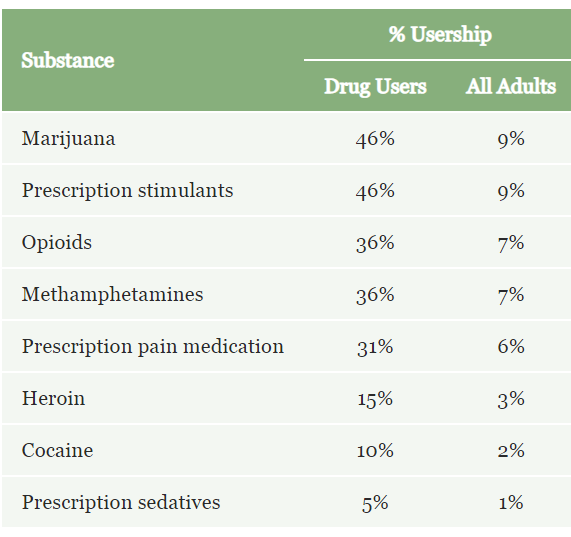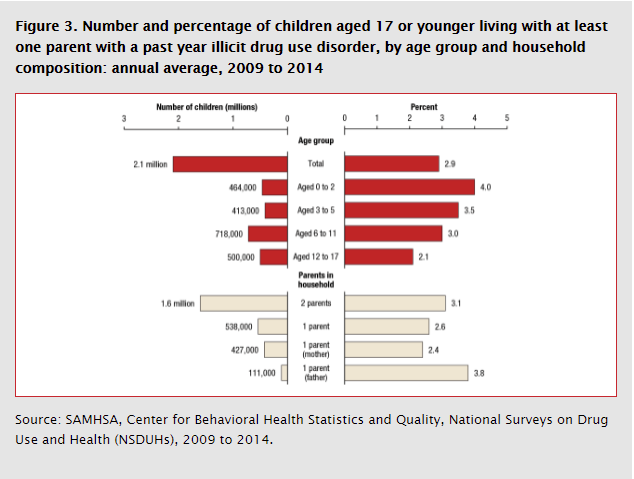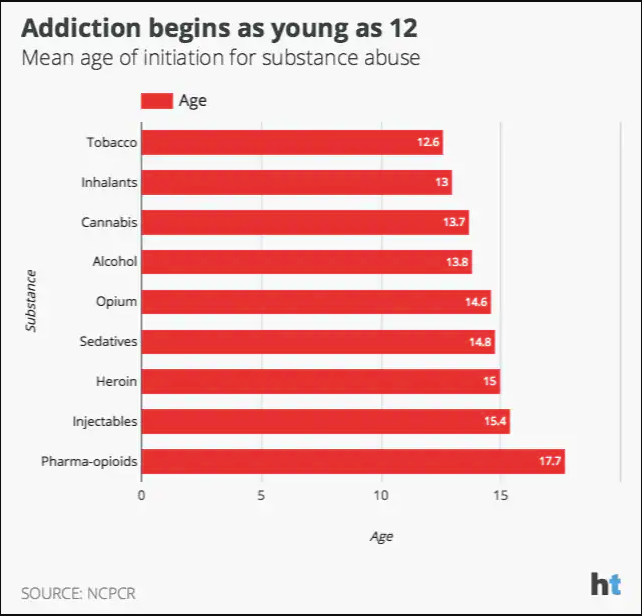This topic is not easy to deal with as people may have contradicting opinions. This post will explain why drug abuse is more common with teens whose family members abuse drugs.
The question is – are kids with drug-abusing parents likely to become addicted, too? Let us start this discussion by presenting to you some statistics that can give you a glimpse of the direction of this post.
According to the National Council on Alcoholism and Drug Dependence or NCADD, drug addiction and alcoholism directly affect the whole family regardless of age.
- An estimated 20 million Americans aged 12 and up (8 percent of the population) had used an illegal substance for the past 30 days. You can read about underage drug addiction more.
- Every year, more teenagers enter addiction treatment with a primary diagnosis of marijuana dependency than with any other illegal drug combined.
- According to statistics from the combined 2009–2014 National Surveys on Drug Use and Health, approximately one in every eight children (8.7 million) aged 17 or younger live with at least one parent who had a prior year substance use disorder (SUD).
- One in every 35 children (2.1 million) lived in a household with at least one parent who had an illicit substance use disorder in the previous year.
These statistics are quite alarming, and if not dealt with properly, they will worsen and significantly affect every child’s future. Also, info about US’s highest drug use cities may be interesting for you.
Let’s go deeper into the topic.
What is Drug Abuse?
Addiction is a disorder of the brain and behavior. When you’re addicted to drugs, you can’t stop yourself from using them, no matter how dangerous they are. So the sooner you seek treatment for drug addiction, the more likely you are to prevent some of the disease’s more severe repercussions.
Addiction is not limited to heroin, cocaine, or other illegal narcotics. Alcohol, nicotine, sleep and anti-anxiety drugs, and other legal substances can all lead to addiction.
You can also become addicted to narcotic pain relievers, generally known as opioids, whether purchased legitimately or illegally. In the United States, this problem has reached epidemic proportions. Opioids were responsible for two-thirds of all drug overdose deaths in 2018.
You may initially opt to consume a drug because you enjoy the way it makes you feel. You may believe you have control over how much and how frequently you use it. However, medicines alter the way your brain functions over time. These physical alterations can be long-lasting. They cause you to lose control and can result in harmful behavior.
What are the Most Commonly Used Psychoactive Substances among U.S. Parents?
Psychoactive substances, often known as psychotropic drugs, are chemical substances that alter a person’s mental state by influencing how the brain and nervous system function. This can result in drunkenness, which is frequently the primary reason people choose to use psychoactive drugs.
People who take psychoactive substances undergo changes in brain function that impact their perceptions, feelings, and/or consciousness.
Psychoactive Drugs Groupings
Stimulants, narcotics (opioids), hallucinogens, depressants, and marijuana (cannabis) are examples of psychoactive drugs.
Stimulants
The most commonly abused stimulants are as follows:
- Nicotine
- Cocaine
- Caffeine
- Amphetamines
A person abusing the stimulants mentioned above may experience the following effects:
- Excitability
- Greater energy
- Heightened alertness
- Increased heart rate and blood pressure
- Improvement in mood that can reach euphoria
Opioids
Opioids are extracted from the poppy plant or produced synthetically. Some of the commonly abused opioids are:
- Painkillers like morphine, oxycodone, codeine, and heroin are commonly known as street drugs.
Abusing the above may cause you the following effects:
- Pain relief
- Euphoria
- Respiratory depression
- Drowsiness
- Confusion
Hallucinogens
Some of the commonly used hallucinogens are as follows:
- Psilocybin from mushrooms
- Dextromethorphan
- Ketamine
- Peyote (mescaline)
- Phencyclidine (PCP)
This group of substances may result in the following:
- Paranoia
- Increased blood pressure and heart rate
- Depersonalization
- Hallucinations
- Erratic behavior
Depressants
Benzodiazepines are the most popular depressant usually used by adults. Some of its effects are as follows:
- Reduced feeling of tension
- Muscle relaxation
- Relief of anxiety
Excessive use of the substance can cause
- Rapid and weak pulse
- Clammy skin
- Slow and shallow breathing
- Death
- Coma
See the chart below from drugabusestatistics.org on users of the substances commonly abused by adults, particularly the parents.

Why is Drug Abuse More Common with Teens Whose Family Members Abuse Drugs?
Regardless of age, the people who raise us have a profound influence on us. These impacts include the DNA we acquire from our biological parents and the behaviors, habits, attitudes, and communication styles we learn from our adult caregivers. The same principle holds for how we use alcohol or drugs.
According to the National Institute on Drug Abuse, 25% of American children grow up in substance abuse homes. According to Current Drug Abuse Reviews, kids with drug addict parents are nearly twice as likely to develop addiction problems themselves. These youngsters are also more prone to suffer from:
- A higher risk of developing depression or anxiety
- A greater chance of becoming addicted once they start using drugs or alcohol
- A higher risk of sexual, verbal, or physical abuse
- Emotional and behavioral problems
- Low self-esteem
- Earlier onset of experimentation with drugs or alcohol
- Poor school performance
The table below shows how vulnerable kids are if their parents abuse drugs based on the different studies.
| Source | Concept | Participants | Process | Results |
| Kandel (1990) | Parenting Styles |
| Parents were instructed to complete self-report assessments of the following:
| Mothers who had used drugs or drank heavily in the previous year were more prone to commit the following:
Fathers with a history of drug use exhibited the following:
Father’s alcohol and drug use in the last year was associated with:
|
| R. T. Ammerman, D. J. Kolko, L. Kirisci, T. C. Blackson, M. A. Dawes (1999) | Child Maltreatment | 290 boys (aged 10–12-year-old) Their biological mothers and fathers were both with and without a SUD diagnosis; families were intact | Parents were asked to perform the following:
Children completed self-report measures and measures regarding their parents. | Mothers and fathers with a history of SUD resulted to following:
|
| Eiden, Edwards, & Leonard (2002) | Parenting Styles | 223 infants (12-month-old) and their parents were studied; a community sample of mothers and fathers with and without a SUD diagnosis was used; the control group was matched on demographically |
|
|
| Kelleher, Chaffin, Hollenberg, & Fischer (1994) | Child Mistreatment | 11,662 adults from 4 different communities were studied; 378 adults reported neglecting or physically abusing their kid; a control group of 378 adults was matched on community, gender, age, race, and socioeconomic status. | All participants completed the DIS.
|
|
The Effects of Parental Substance Abuse on Children and Families
Parental SUDs have a negative impact on the family by disrupting bonding, rituals, roles, routines, communication, social life, and money. In addition, a parental SUD creates an environment of secrecy, loss, conflict, violence or abuse, emotional upheaval, role reversal, and terror in families.

Source: samhsa.gov
NSDUH data is likewise used to estimate the number of children who live with at least one parent who has had an illicit drug use disorder in the previous year. Below are important facts regarding children of drug-addicted parents which authorities should focus on. These are not just numbers. These are lives of the children that might get ruined if no action is taken.
- Around 2.1 million or 2.9% of children aged 17 years old or below live in a house with at least one parent who abused drugs.
- 500,000 12 to 17 years old or 2.1% live with at least one parent who is into drugs.
- 718,000 children aged 6 to 11 or 3% have a parent suffering from illicit drug disorder.
- 413,000 children with the age bracket of 3 to 5 years old or 3.5% have the same situation.
- 464,000 children aged 0 to 2 or 4% have at least one parent involved in substance abuse.
The previous study has indicated that children of parents with an illegal drug use problem are at a higher risk for mental and behavioral disorders and functional impairments than children of parents with an alcohol use disorder. Just imagine if this will not stop and the number continues to rise.
Estimates of the number of children living with at least one SUD parent are needed for adult prevention campaigns and programs that support and protect afflicted children. Early intervention should be applied to prevent any harmful effects on children. Former drug addicts’ advice to parents can be very helpful.
What are the chances that a Kid with Drug Abusing Parents will Become a Drug Addict in the Future?

Parents have a powerful influence over their children, and they have the most impact on whether or not their child will engage in drug abuse and addiction. Drug-addicted mothers’ effects on children are more serious since they are always with them. If they see you getting addicted to a substance at an early age, they will think it’s the right thing to do. As a result, they will do the same thing, thinking that it’s okay because they see it from their parents.
Aside from your children, other family members will also become addicted to the substance. The chances of having more than one member in a family with a problem are high. This will create a pattern of addiction, and the cycle will continue if nobody breaks the chain.
The possibility of a child with at least one parent into drug addiction to become a drug addict in the future is eight times more likely compared to a drug-free family.
Effects of Parental Substance Abuse on Children and Families
When drugs are abused in a family, behavior is unpredictable, and communication is hazy. As a result, family life is marked by disorder and unpredictability. The behavior of a person might range from loving to withdrawn to insane. Structure and rules may be absent or inconsistent. Children who are unaware that their parent’s conduct and mood are influenced by the amount of alcohol or other drugs in their system may feel confused and uneasy.
Children Feel Neglected and Blame Themselves
People say children of drug addicts are frequently neglected. They care about their parents and love them, but they are furious and saddened because their parents do not love them enough to stop using.
Despite their hardship, many of these youngsters blame themselves for their parent’s substance misuse. They believe that their parents yell when their children don’t stop fighting, don’t care to keep the room clean, don’t get higher grades. In turn, they would drink or do drugs.
Some kids try to keep their drinking or drug usage under control by obtaining straight A’s, keeping the house clean, and getting along well with their siblings. Others retreat, hoping not to cause any disruption that would lead to a parent drinking or using. Finally, a few people recognize that children cannot make their parents drink or take drugs, nor treat their parents’ substance abuse problems.
Kids May Experience Post-Traumatic Stress Syndrome
Children of substance abusers are frequently terrified. They can be the victims of physical assault or incestuous relationships. They may also see violence – alcohol and other substance abuse usually coexists with domestic violence. In addition, drug-addicted parents’ effects on children’s life are quite alarming.
As a result, these children may experience post-traumatic stress syndrome, with symptoms such as sleep difficulties, flashbacks, depression, and anxiety common among victims of war crimes. These youngsters are concerned for their safety, and possibly parents can become ill or die due to their drinking or drug use. They are aware that their dad may drive drunk or get into confrontations on the street. In this case, parental drug use and child protection are needed.
Risk for Emotional, Mental and Physical Health Problems
Substance misuse by a parent disrupts a child’s normal development, putting these children at a higher risk for emotional, mental, and physical health problems. Because parents who abuse alcohol or other drugs are more likely to experience domestic violence, mental illness, unemployment, divorce, and legal issues, their capacity to parent effectively is significantly hampered.
Children of substance abusers (COSA) are more likely than their classmates to suffer from depression, eating disorders, anxiety, and suicidal ideation. Furthermore, COSAs are three to four times more likely than the general population to develop an addiction to alcohol or other drugs.
Sexual and Physical Abuse of Children
Sexual and physical abuse of children is more prevalent in homes when one parent abuses drugs. In addition, sexual abuse is more common in chaotic and dysfunctional homes when communication breaks down, and responsibilities are ambiguous.
Children who grow up in high-conflict households have poorer self-esteem and weaker internal control. This increases the likelihood of COSAs being re-victimized in the future. For example, Female COSAs are more likely to be involved with substance-abusing men, leaving them vulnerable to further abuse.
Educational Consequences
Children from substance-abusing households are more likely to have learning difficulties, attend more schools, repeat more grades, be truant, delinquent, and drop out of school due to pregnancy, expulsion, or institutionalization.
Final Thoughts
The above facts and data are insufficient to explain why drug abuse is more common among teens whose family members abuse drugs. However, the studies conducted by various agencies can provide a clearer view of the consequences of having parents who use drugs.
However, the truth remains that most children of substance abusers do not end in disaster. Only one in every four children with at least one substance abuser parent will become drug abusers, whereas the other three will not. Most children and teenagers can cope with their surroundings and achieve in life by drawing on their inner qualities. Children exposed to drug-abusing households can be assisted in various formal and informal ways to tap into their resiliency.
If you are struggling with such a problem, we highly recommend you consult with a doctor. If the drug testing is already coming, read the article about THC detox.

